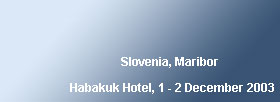OBJECTIVES
OF THE CONGRESS
Current state of the railway system
Due to the implementation of the fundamental concept of four
freedoms (free movement of goods, services, persons and capital)
the railway system of the European Union was developed and
designed in order to to increase the efficiency of railway
services. Uncontrollable growth of road transport has given
rise to a difficult and complex problem, i.e. how to limit
this development and stimulate alternative forms of transport.
The side effects of being able to chose among various transport
services and of the gradually increasing mobility are the
following:
- saturation of main roads and railway connections, cities
and airports:
- 10% of the entire road system (7500 km)
- 20% of the entire railway system (16000 km)
- 30% of all flights on main European airports have
a delay of more than 15 minutes
- uneven growth of different transport modes
- isolation of some regions
- damaging effects of traffic to nature and health
- total expenditure in the field of transport in the EU
amounts to1000 billion EURO, which is more than 10% of the
total GDP in the EU, providing more than 10 million jobs
- 41000 fatalities each year = 2% GDP of the EU
Trends to be expected until 2010:
- 38% increase in freight transport
- 24% increase in passenger transport
- 3 million new car registrations
- 50 % increase in heavy vehicles transport
- increased energy consumption due to traffic
- increased air pollution
- more climatic changes
- a higher level of noise
To avoid such negative trends, the European Commission issued
a White Paper on ‘Common European Transport Policy for 2010’,
comprising exact measures in the field of transport. These
measures aim at decreasing the effects of economic growth
on the increase of traffic, without restricting mobility and
efficient use of different modes of transport.
In order to prevent discriminatory access to railway infrastructure
and facilitate adjustment of the railway system to these new
guidelines, the European Union issued following regulatory
railway legislation, comprising different directives:
- Directive 91/440/EEC on railway development
- Directive 2001/12/EC amending Council Directive 91/440/EEC
on railway development
- Directive 95/18/EC on the licensing of railway undertakings
- Directive 2001/13/EC amending Council Directive 95/440/EEC
on the licensing of railway undertakings
- Directive 2001/14/EC on the allocation of railway infrastructure
capacity and the levying of charges for the use of railway
infrastructure and safety certification
- Directive 96/48/EC on the interoperability of the trans-European
high speed rail system
- Directive 2001/16/EC on interoperability of the trans-European
conventional system
The Republic of Slovenia is striving towards the same objectives,
and has demonstrated such by signing the association agreement
The process of adjusting Slovene legislation in the field
of railway transport has brought about a new Bill on Railway
Transport (Zzel-UPB1), which is in full accordance with the
demands of the EU. This new law is a milestone in the process
of separating railway infrastructure management from transport
service operation in Slovenia.
This means that the old notions of how these services should
be organised and the consequent (exclusive) competence of
railway companies are now changing dramatically. We have got
two new business subjects , i.e. one with exclusive competence
in the field of railway infrastructure management and the
other in the field of transport service operation. Both share
the same infrastructure and they form together the complete
range of railway transport services.
Therefore, the level of technical quality of the existing
railway infrastructure has to be improved. This will enhance
the possibility of successfully integrating the railway system
into the transport system as a whole, as this was done in
other European countries. At the same time, this will enable
a better utilisation of (environmentally friendly) railway
transport, diminish the level of exhaust emissions, offer
a more natural traffic development and improve the general
quality of life.
The newly founded railway infrastructure managers are thus
facing the challenge of defining and selecting the optimal
management system for each transport system.
A contribution to the pursuit of these objectives
In order to contribute to the solution of the existing problems,
we decided to organize the 1st Congress of Railway Infrastructure
Managers. Together we shall discuss good and bad practices
in railway infrastructure management, develop new ideas and
concepts of management and establish new relationships between
railway infrastructure managers from different European countries.
Aims and objectives of the congress
- to develop a railway infrastructure management system,
comparable to the ones on a European level
- to introduce the role and importance of rail infrastructure
managers to the general public
- to exchange experience in rail infrastructure management
- to introduce good practices of individual managers
- to introduce the association of European Rail Infrastructure
Managers (EIM)
- to introduce the Slovene Rail Infrastructure Manager
(A®P)
- to inform experts on the current state of affairs with
the Slovenian as well as the European rail infrastructure
managers
|


